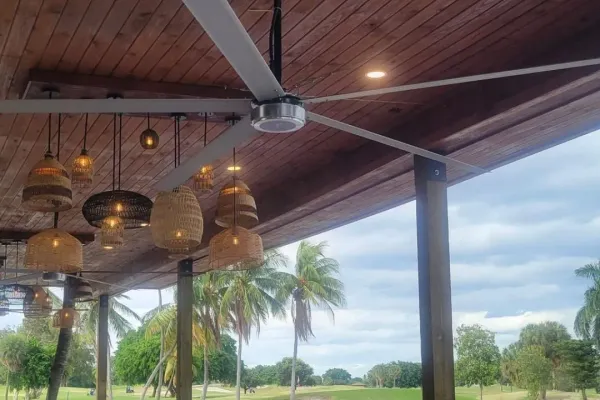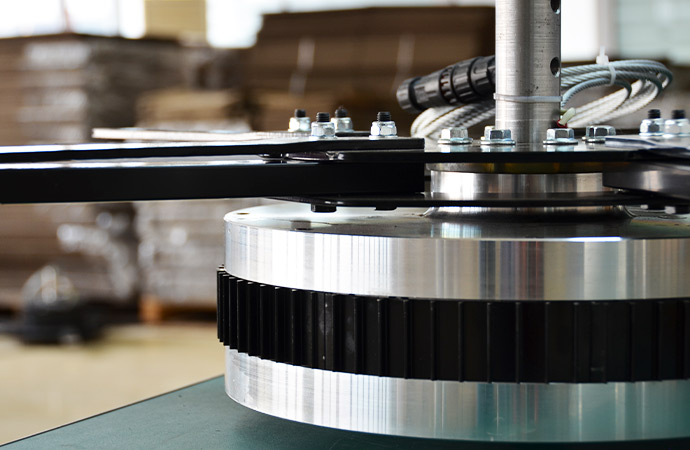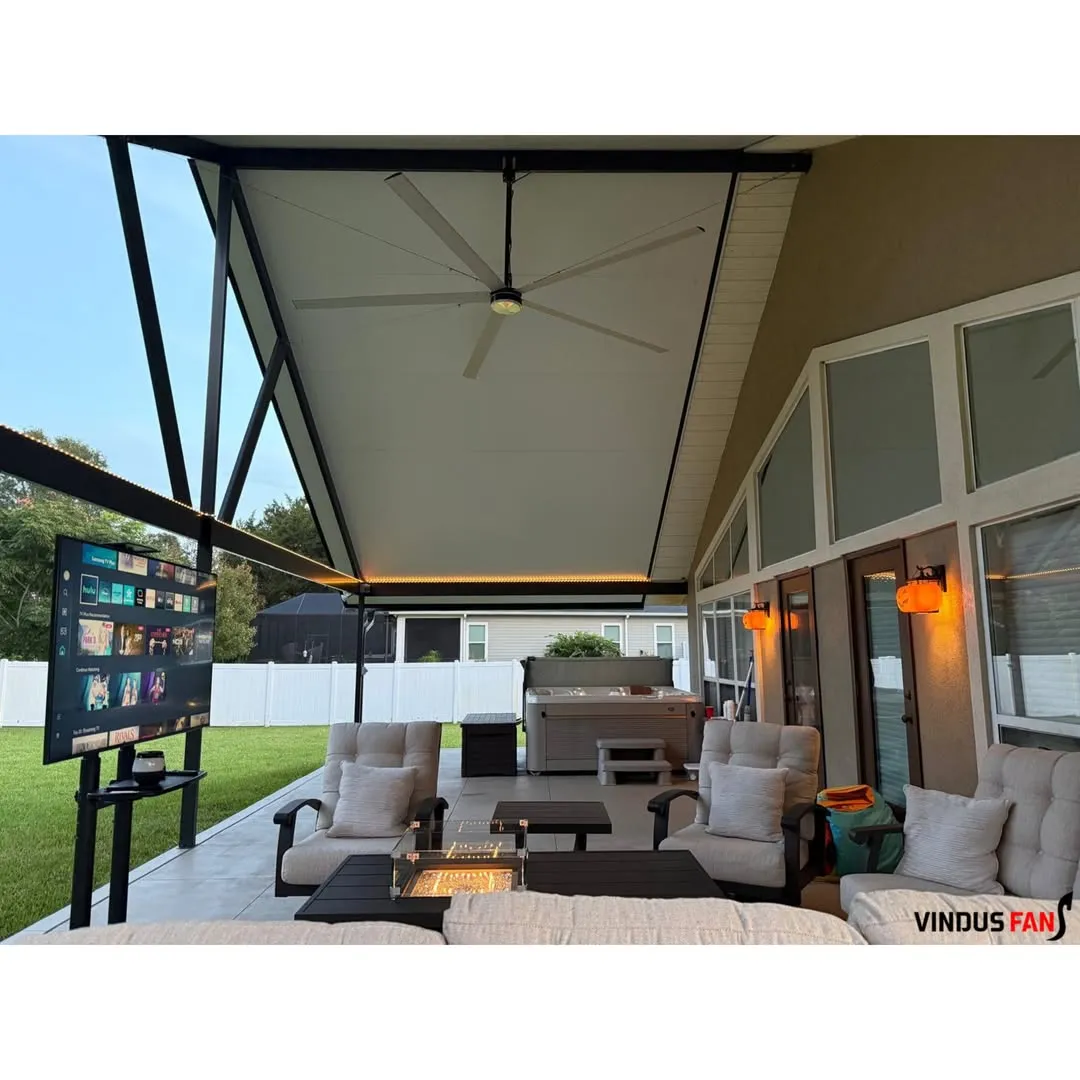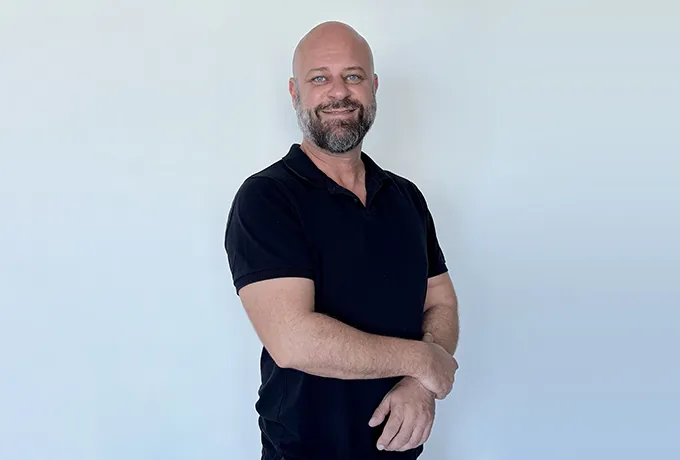Poor air circulation in large commercial and industrial spaces leads to uncomfortable environments, increased energy costs, and reduced productivity. Ignoring this problem only worsens it, especially during hot summer months. The solution? Outdoor commercial ceiling fans designed for rugged performance, powerful airflow, and energy-efficient climate control.
Outdoor commercial ceiling fans use large, slow-rotating blades—often 96 inches or more—to provide powerful air circulation across big, open spaces. They help reduce temperature differences, boost comfort, lower energy costs, and protect equipment from moisture. Industrial ceiling fans are built for heavy-duty use, featuring corrosion-resistant motors and blades suitable for all climates.

commercial hvls fans in large open space
Factories, commercial buildings, warehouses, and gyms often struggle to maintain cool and comfortable environments, especially in spaces with high ceilings and large floor areas. Standard ceiling fans simply can’t deliver enough airflow or durability for these applications.
Without proper airflow solutions, heat and humidity accumulate near the ceiling, leading to uncomfortable work environments, wasted energy, and inconsistent temperatures. This can cause employee fatigue, product spoilage, equipment malfunction, and even safety hazards.
Outdoor commercial ceiling fans—especially industrial ceiling fans—offer maximum airflow with heavy-duty, corrosion-resistant motors and blades. They are designed to circulate a high volume of air at low speeds, ensuring consistent temperature and humidity control from the ceiling to the floor. These fans offer durability in wet-rated and rugged settings like barns and warehouses.
Stat: Studies show HVLS industrial fans can lower perceived temperatures by up to 8°C and reduce HVAC energy costs by 20-30% in large commercial and industrial spaces. [ASHRAE Handbook]
For a complete guide on choosing the right fan for your warehouse, see Warehouse Ceiling Fan Solutions
%Industrial ceiling fan for warehouse airflow
Air Circulation Challenges:
Traditional residential ceiling fans are not designed for the demands of large industrial spaces. Industrial ceiling fans feature much larger blades—typically 72 inches, 96 inches, or even more—and heavy-duty motors that create a high volume of air movement.
How They Work:
Industrial ceiling fans use slow-rotating, aerodynamic fan blades to push air downward, creating a gentle breeze across the entire floor area. This destratifies the air, preventing hot or cold spots and ensuring uniform temperature distribution.
Benefits:
Quote:
“After installing HVLS ceiling fans, our manufacturing facility saw a 25% reduction in cooling costs and a noticeable boost in worker morale.”
— Facility Manager, Automotive Plant
Discover the science behind airflow improvement in our Airflow Solutions for Industrial Spaces article.
| विशेषता | औद्योगिक छत पंखा | Standard Ceiling Fans |
|---|---|---|
| ब्लेड का आकार | 72-96 inches and larger | 36-60 inches |
| वायु प्रवाह (सीएफएम) | 200,000+ | 5,000-10,000 |
| मोटर | Heavy-duty, DC or AC | Light-duty, AC |
| आवेदन | Warehouse, gym, barn, factory | Homes, small offices |
| Mounting Height | 10-30 meters | 2.5-4 meters |
| सहनशीलता | Corrosion-resistant, wet-rated | Not suitable for harsh conditions |
| ऊर्जा दक्षता | High volume of air at low speed | Lower volume, higher RPM |
| Special Features | Reversible, LED light, DC motor, downrod | Basic |
Tip: One 96-inch industrial ceiling fan can replace up to 20 standard ceiling fans in a typical warehouse or gym, saving space and maintenance costs.
Read our Comparison of Industrial and Commercial Ceiling Fans
Quick Sizing Reference Table
| आवेदन | छत की ऊंचाई | पंखे का व्यास | Recommended Model |
|---|---|---|---|
| गोदाम | 10-30 meters | 96-144 inches | HVLS Industrial |
| Gymnasium | 8-18 meters | 72-96 inches | वाणिज्यिक पंखा |
| Barn | 8-20 meters | 72-120 inches | Agricultural Fan |
| Food Service Hall | 5-12 meters | 60-96 inches | Wet-Rated Fan |
| Retail Space | 3-6 meters | 60-72 inches | Standard Fan |
Ceiling Fan Selection Tips:
Fact: Our HVLS industrial fans for commercial and industrial ceiling fans offer durability, reliability, and long service life in even the toughest work environments.
Not sure about sizing? Visit How to Choose the Right Size HVLS Fan
Blade Shape & Material:
The design and material of fan blades play a crucial role in air circulation. Industrial ceiling fan blades are typically made of lightweight aluminum or corrosion-resistant composite materials. The blade’s shape (twisted or airfoil) helps maximize air movement while minimizing energy use.
Number of Blades:
Most HVLS fans use 6-8 long, wide blades to move a high volume of air at low speed. More blades often mean quieter operation and smoother airflow.
Blade Angle (Pitch):
A greater pitch increases airflow, while a flatter pitch saves energy. Optimized blade design ensures a balance between high volume of air and low power consumption.
Durability:
Our industrial ceiling fan blades are tested for heavy-duty performance, making them ideal for spaces like warehouses, barns, gyms, and food service environments.
केस स्टडी: A logistics warehouse improved their product preservation and reduced spoilage by 18% after upgrading to corrosion-resistant industrial ceiling fans.
Internal Link: Learn more about Industrial Fan Blade Design
DC Motor
Industrial ceiling fans equipped with DC motors are more energy-efficient than traditional AC models. DC motors offer quieter operation, smoother speed transitions, and up to 70% lower energy consumption. The advanced motor design provides high torque at low speed, which is ideal for producing a powerful air circulation effect with minimal noise.
AC Motor
While AC motors are common in residential ceiling fans, their efficiency and lifespan are not optimized for heavy-duty commercial use. For large industrial ceiling fans, the robust and reliable DC motor is recommended for continuous use in warehouses, gyms, and factories.
Downrod and Control
DC motor fans support advanced remote or wall controls and reversible features. Combined with a long downrod, these fans can deliver airflow solutions even in facilities with very high ceilings.
Fact: DC motor industrial ceiling fans can reduce HVAC-related energy costs by 30% per year in large commercial settings.
Read more about DC Motor Ceiling Fans for Industry

DC Motor Ceiling Fans for Industry
Versatility for Any Environment
Industrial ceiling fans are designed to perform in both indoor and outdoor settings. Wet-rated models with corrosion-resistant bronze finishes and sealed motors handle moisture, dust, and temperature extremes. This makes them perfect for barns, open-air food service areas, and even outdoor gyms.
Durability and Safety
These fans offer durability under continuous operation, whether in a factory, warehouse, or a commercial space exposed to rain and humidity. The outdoor rated ceiling fan ensures safety in harsh climates with heavy-duty seals and electrical protections.
Residential Ceiling Applications
While residential ceiling fans are not suitable for industrial use, some smaller HVLS fans can be used in large homes with open plans or indoor pools.
For more on mixed-use options, see Commercial Ceiling Fans for Indoor and Outdoor Use

Commercial Ceiling Fans for Indoor and Outdoor Use
Dual Functionality
A ceiling fan with light combines illumination and airflow in one fixture. This saves space and installation time, which is especially useful for gyms, warehouses, and large retail spaces. Modern LED lights are energy-efficient, long-lasting, and do not produce additional heat.
Design Options
Industrial and commercial ceiling fans with LED lights are available in bronze, white, and other finishes to suit any décor or branding needs. They can be dimmable and compatible with automated building management systems.
रखरखाव
With LED lights lasting over 50,000 hours, maintenance costs are kept to a minimum—ideal for work environments where downtime is expensive.
Stat: Facilities that upgrade to LED-equipped industrial ceiling fans reduce lighting energy usage by up to 60%.
ग्रीष्मकालीन मोड
During warm months, the fan blades rotate forward, pushing air downward to create a cooling effect and circulate air throughout the building or facility. This maximizes comfort in gyms, barns, and food service environments.
Winter Mode (Reverse)
The reversible feature allows the ceiling fan to pull cooler air up, redistributing warm air that rises to the ceiling. This keeps floors warm in winter and reduces heating bills, supporting climate control and reducing energy costs.
Tip: Switching to reverse mode during winter can save up to 20% on heating costs in large industrial spaces.
Learn more about Reversible Ceiling Fans for All Seasons
Destratification Explained
In large spaces, warm air rises and cool air stays near the floor. HVLS (High Volume, Low Speed) industrial ceiling fans destratify the air by gently mixing the layers, ensuring even temperature from ceiling to floor.
फ़ायदे
केस स्टडी
A logistics company replaced standard ceiling fans with two 96-inch HVLS industrial fans. As a result, temperature differences between floor and ceiling dropped from 11°C to 2°C, and energy usage declined by 26%.
Read more about Destratification with HVLS Ceiling Fans
Installation Checklist
Maintenance Tips
Quote: “We schedule quarterly maintenance on all our industrial ceiling fans to ensure continuous, safe operation with zero downtime.” — Facility Engineer, Logistics Center
Download our full Ceiling Fan Maintenance Guide
A manufacturing facility upgraded to HVLS industrial ceiling fans. After installation, the indoor temperature dropped by 7°C and employee complaints about heat and air quality fell by 60%. The annual energy savings paid for the upgrade in just 18 months.
A commercial gym installed six 96-inch outdoor rated ceiling fans. Membership retention improved, and summer air conditioning bills dropped by 30%.
A busy food court used heavy-duty, wet-rated ceiling fans to maintain air circulation and comfort. Even during summer months, customer satisfaction scores rose.
Internal Link: See more Industrial Fan Case Studies
How do I select the right size industrial ceiling fan for my facility?
Measure your floor area and ceiling height. Choose a fan that covers the entire open space. For large warehouses, a 96-inch HVLS industrial ceiling fan is often best.
Can commercial ceiling fans be used in wet or dusty environments?
Yes, always choose wet-rated or outdoor ceiling fans for such conditions. These offer corrosion-resistant finishes and sealed motors.
Do industrial ceiling fans really reduce energy costs?
Absolutely. Facilities often see 20–30% savings on heating and cooling costs thanks to improved air movement and destratification.
What’s the difference between standard ceiling fans and large industrial ceiling fans?
Standard fans are for residential or small office use, while industrial ceiling fans are built for heavy-duty, large-scale airflow solutions with much larger blades and stronger motors.
Can ceiling fans be integrated into building automation systems?
Yes. Many modern HVLS industrial fans offer BACnet or Modbus compatibility for smart climate control.
How often should I maintain my industrial ceiling fans?
Inspect fans every month and perform a thorough maintenance check quarterly to ensure durability and safety.

हाय मैं हूँ माइकल डेनियलसनविन्डस फैन्स के सीईओ, इंजीनियरिंग और डिजाइन उद्योग में 15 से अधिक वर्षों के अनुभव के साथ। मैं यहाँ जो कुछ भी सीखा है उसे साझा करने के लिए हूँ। यदि आपके पास कोई प्रश्न है, तो बेझिझक मुझसे किसी भी समय संपर्क करें। आइए साथ मिलकर आगे बढ़ें!